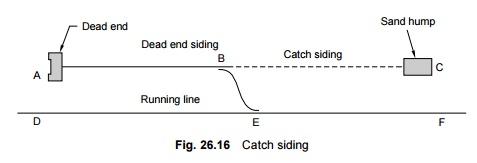Chapter: Civil : Railway Airport Harbour Engineering : Railway Engineering : Railway Stations and Yards
Catch Sidings and Slip Sidings

Catch Sidings and Slip Sidings
Catch sidings are provided in the
case of hilly terrains, where the gradients near railway stations are very
steep. The purpose of catch sidings is to arrest the movement of the vehicles if
they start to roll down the grade, which may eventually foul up the running
lines. A separate siding is provided outside the station yard so that the
vehicles can be collected there.
In Fig.
26.16, DEF is a running line and AB is a dead end siding. BC is the catch
siding connected to the dead end siding preferably by the means of a
spring-operated point. The catch siding lies on a rising gradient and its
length is so designed that the vehicle loses its kinetic energy when it reaches
the dead end. Thus the vehicle is protected from damage and the safety of the
trains on the running line is ensured. There is a sand hump provided at the end
of the catch siding to prevent any minor damage to the vehicle.
In the case of hilly terrains,
normally one siding is provided at each end of the station as explained here.
Catch sidings These are
provided at the higher level or upper end of a station when it starts to
slope downwards along the track in an unauthorized manner from the previous
station.
Slip sidings These are
provided at the lower level on the lower end of the station. If by
chance the vehicle is not caught in a catch siding and enters the station
premises, the same will be caught and shipped into the slip siding.
Clapham
Junction (London) of the Southern Region on British Railways is probably the
greatest junction station in the world. It has 17 platforms but 12 of these
lines are used by trains that either make only an ordinary station stop or do
not stop at all. The other five platforms are used for miscellaneous purposes
and are chiefly provided for trains transporting milk and other similar
articles, which require a significant stop before the lines can be cleared.
Thus, as many as 2500 trains can run daily with ease from this station, as very
few trains occupy the platform for more than a minute or so.
Related Topics